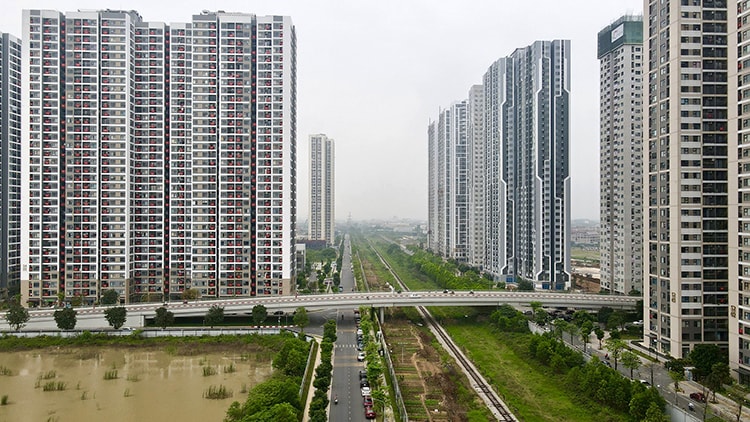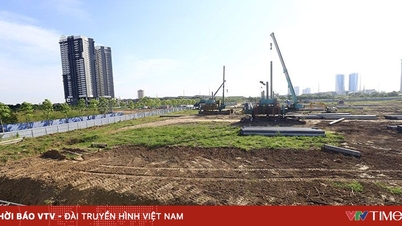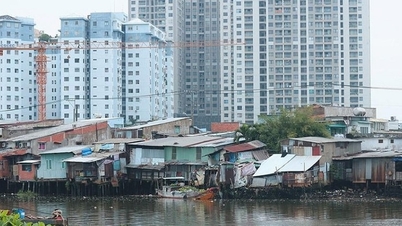The rich hold land, the young hold… worries
According to the report of the Vietnam Association of Realtors (VARS), the Vietnamese real estate market is increasingly demonstrating its great and important role, receiving special attention from people, investors as well as policy makers.
According to the General Statistics Office (now the General Statistics Office, Ministry of Finance ), the average contribution of the construction and real estate industry to the country's total GDP in recent years has been about 10%. Of which, the real estate industry directly accounts for about 3.5%, contributing an average of about 0.5 percentage points to GDP growth.
However, the average contribution of the construction and real estate industry to Vietnam's GDP is only about 50% compared to other countries in the region.

The scale of real estate compared to total economic assets has only reached about 21% - significantly lower than the rate of 35% in developed countries. Thus, the market still has a lot of room for development in the medium and long term.
However, the current development process is showing many signs of unsustainability, especially the imbalance between product structure and the payment ability of the majority of people. In the past three years, although the housing supply has increased, most of it is concentrated in the high-end segment, with high value and mainly serving investment needs, including speculation.
Even in suburban areas, where the demand for affordable housing is expected to be met, actual selling prices still far exceed the average income of the people. Meanwhile, the real demand of the market is still concentrated in the affordable housing segment.
The imbalance between supply and demand has pushed up housing prices, especially apartments in big cities, and established a new price level that far exceeds the rate of income growth. This not only narrows people's access to housing but also poses the risk of forming a price bubble.
Home ownership is becoming increasingly difficult for people. For a two-bedroom apartment costing around VND5 billion, a family earning VND50 million/month would need about eight years if they spent all their income on buying a house, and up to 25 years if they followed the principle of housing costs not exceeding one-third of their income.
Even social housing, which is for low-income earners, is no longer “cheap”. A 60 m2 apartment costs about 1.5 billion VND, which means that a household with the maximum income according to regulations (40 million VND/month) still has to save for about 10 years, or even longer if using a loan.
As a result, the gap between the group that owns assets and the group that does not own assets is increasing. Those who own real estate continue to benefit from the increase in land value, while those who do not own a house are at risk of having to rent a house for a long time, despite efforts to improve their income. Without timely solutions, the gap between rich and poor may even be "fixed" for many generations, directly affecting social security and sustainable urbanization.
Solutions are needed to "brake" the hot growth of housing prices.
VARS believes that in order for the real estate market to continue to grow sustainably, there needs to be a solution to "brake" the rapid growth of housing prices, by clearing the supply of affordable housing. When the supply is large enough, market prices will self-regulate according to the real balance of supply and demand.
Firstly, speed up the completion of the legal system and improve enforcement capacity at the local level. The handling of bottlenecks in site clearance needs to be done transparently and effectively, shortening project implementation time while still ensuring people's rights.

At the same time, it is necessary to consider abolishing the regulation on collecting an additional 5.4%/year on late land use fees and promptly promulgate a clear method for determining land use fees to reduce project development costs and create room for housing price reduction.
Second, it is necessary to diversify capital channels for the real estate market to reduce dependence on bank credit. Restructure the corporate bond market to become an effective medium- and long-term capital source. At the same time, it is necessary to promote the formation of a National Housing Fund and develop Real Estate Investment Trusts (REITs).
Third, social housing and affordable housing projects must be prioritized in planning and have incentive mechanisms. Urban development must be linked to transport infrastructure, especially belt roads, metro and highways to expand urban space and reduce pressure on land prices in the center. At the same time, it is necessary to develop a professional rental market, reducing the mentality of "having to own a house to stabilize life".
Fourth, it is necessary to research and promulgate sets of criteria and standards for monitoring and early warning of real estate market developments, as a basis for assessing, classifying and monitoring the activities of market entities.
Through this index system, management agencies can promptly detect signs of "deviation", such as speculation, supply-demand imbalance, abnormal price increases or local liquidity decline, in order to take appropriate intervention and adjustment measures.
Building this proactive monitoring mechanism will help prevent risks and stabilize the market early and from afar, instead of only handling problems when they have become apparent, causing chain reactions and being difficult to control.
In addition, it is necessary to speed up the construction and completion of a unified, synchronous and transparent database on land, housing and real estate market nationwide.
This will be an important information infrastructure to help state management agencies, research organizations and businesses monitor, analyze, forecast and operate the market promptly and accurately.
“The establishment of an open, interconnected data system between ministries, sectors and localities – including information on planning, transactions, values, legal status and land use changes – not only helps improve the effectiveness of monitoring and policy making, but also contributes to increasing transparency, minimizing risks, preventing speculation, price manipulation and protecting the legitimate rights of people and businesses,” VARS emphasized.
Source: https://congluan.vn/gia-nha-tang-phi-ma-nguoi-giau-om-dat-nguoi-tre-om-noi-lo-10317311.html



![[Photo] Prime Minister Pham Minh Chinh chairs a meeting on housing policy and the real estate market.](https://vphoto.vietnam.vn/thumb/1200x675/vietnam/resource/IMAGE/2025/11/11/1762838719858_dsc-2107-jpg.webp)






























































































![Dong Nai OCOP transformation: [Article 4] Reaching national standard products](https://vphoto.vietnam.vn/thumb/402x226/vietnam/resource/IMAGE/2025/11/11/1762825820379_4702-cac-san-pham-trai-cay-chung-nhan-ocop-nongnghiep-174649.jpeg)



![Dong Nai OCOP transition: [Article 3] Linking tourism with OCOP product consumption](https://vphoto.vietnam.vn/thumb/402x226/vietnam/resource/IMAGE/2025/11/10/1762739199309_1324-2740-7_n-162543_981.jpeg)






Comment (0)